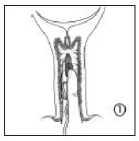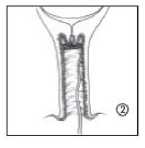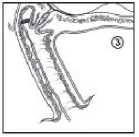Propess 10Mg Vaginal Delivery System
PM-3022/5
PM-3022/5
Read all of this leaflet carefully before you are
given this medicine.
- Keep this leaflet. You may need to read it again.
- If you have any further questions, ask your doctor or nurse.
- If any of the side effects get serious, or if you notice any side effects not listed in this leaflet, please tell your doctor or nurse.
- PROPESS should only be used under the supervision of an appropriate specialist
PROFESS®
10mg vaginal delivery system di noprostone PATIENT INFORMATION
In this leaflet:
1. What PROPESS is and what it is used for
2. Before you are given PROPESS
3. How you are given PROPESS
4. Possible side effects
5. How to store PROPESS
6. Further information
1. WHAT PROPESS IS AND WHAT IT IS USED FOR
PROPESS is used to help start the birth process from the 38th week of pregnancy. The dinoprostone opens the part of the birth canal known as the cervix, to allow the baby through. There can be several reasons why you might need help to start this process. Ask your doctor if you would like to know more.
2. BEFORE YOU ARE GIVEN PROPESS
Do not use PROPESS
You must not be given PROPESS:
• if the size of your baby’s head means there may be a problem during delivery
■ if your baby is not in the correct position in the womb, to be born naturally
■ if your baby is not in good health and/or is distressed
• if you have had more than three full term deliveries
• if you have had previous surgery or rupture of the cervix
* if you have untreated pelvic inflammatory disease (an infection in the womb, ovaries, tubes and/or cervix)
■ if the placenta is obstructing the birth canal
* if you have or have had any unexplained vaginal bleeding during this pregnancy
* if you have had previous womb surgery including a previous Caesarean birth for any earlier babies
* if you are hypersensitive (allergic) to dinoprostone or any of the other ingredients of PROPESS.
The doctor or nurse will not give you PROPESS or will remove it after it has been given to you:
* once labour starts
• if you need to be given a drug such as an oxytocic to help your labour progress
• if your contractions are too strong or prolonged
* if your baby becomes distressed
• if you get side effects (see 4. Possible side effects)
There is limited experience of using PROPESS if your waters have been broken. Your doctor or nurse will remove PROPESS after it has been given to you if your waters break or are going to be broken by the doctor or nurse.
Take special care with PROPESS
Before you are given PROPESS, please inform your doctor or nurse if any of the following apply to you:
* if you have or have ever had asthma (breathing difficulty) or glaucoma (an eye condition)
* if you have suffered from contractions that were too strong or prolonged in a previous pregnancy
* if you have lung, liver or kidney disease
* if you are having more than one baby
* if you are taking a medicine for pain and/or inflammation, containing non-steroidal anti-inflammatory drugs (also known as NSAIDs) e.g. aspirin
* if you are aged 35 or over, if you have had complications during pregnancy, such as diabetes, high blood pressure and low level of thyroid hormones (hypothyroidism), or if the pregnancy is above 40 weeks because of the increased risk of developing disseminated intravascular coagulation (DIC), a rare condition which affects blood clotting.
Taking other medicines
Please tell your doctor or nurse if you are taking or have recently taken any other medicines, including medicines obtained without a prescription.
Pregnancy and breast-feeding
PROPESS is used to help start birth process at term. PROPESS should not be used at other phases of pregnancy or during breast-feeding.
3. HOW YOU ARE GIVEN PROPESS
The doctor or nurse will place one vaginal delivery system next to the cervix in your vagina. You should not do this yourself. Your doctor or nurse will coat the vaginal delivery system with a small amount of lubricating jelly before putting it in place. Sufficient tape will be left outside the vagina, so that the vaginal delivery system can easily be pulled out when it is time to remove it.
You should be lying down during this procedure and you will have to stay that way for about 20-30 minutes after insertion of PROPESS.
When placed in position, the vaginal delivery system takes up some of the moisture there. This allows the dinoprostone to be slowly released.
Whilst the vaginal delivery system is in place helping to start your labour, you will be examined regularly amongst other things for:
• opening of your cervix
• uterine contractions
• labour pains and the continuing health of your baby
The doctor or nurse will decide how long PROPESS needs to be kept in place, depending on your progress. PROPESS can be left in place for a maximum of 24 hours.
On removal of the product from the vagina the vaginal delivery system will have swollen to 2-3 times of its original size and be pliable.
If you have been given more PROPESS than you should
If you are given too much PROPESS it may lead to increasing contractions or the baby may become distressed. The PROPESS vaginal delivery system will then be taken out immediately.
Please turn over-

4. POSSIBLE SIDE EFFECTS
Like all medicines, PROPESS can cause side effects, although not everybody gets them.
A common side effect (affecting less than 1 of every 10 women treated) is increased contractions which may or may not affect the baby. The baby may become distressed and/or its heart rate could become faster or slower than normal.
5. HOW TO STORE PROPESS
Keep out of the reach and sight of children.
Do not use PROPESS after the expiry date which is stated on the foil sachet and the carton.
Store in a freezer. Store in the original container in order to protect from moisture.
Uncommon side effects (affecting less than 1 of every 100 women treated) are nausea (feeling sick), or vomiting (being sick) and diarrhoea.
Medicines should not be disposed of via wastewater or household waste. After usage, your doctor or nurse will dispose of the whole product as clinical waste. These measures will help to protect the environment.
Rare side effects (affecting less than 1 of every 1000 women treated) are rupture of the utems or Disseminated Intravascular Coagulation (DIC), a rare condition which affects blood clotting. This can cause blood clots to form and may increase the risk of bleeding. The chance of developing DIC may be higher during treatment with PROPESS if you are aged 35 years or over; if the pregnancy is above 40 weeks; or you have had complications during the pregnancy e.g. diabetes, high blood pressure or a low level of thyroid hormones (hypothyroidism).
6. FURTHER INFORMATION
What PROPESS contains
- The active substance is dinoprostone, more commonly known as Prostaglandin E2. There is 10 mg of dinoprostone in each vaginal delivery system which is released at approximately 0.3 mg per hour over 24 hours.
- The other ingredients are crosslinked polyethylene glycol (hydrogel) and polyester yarn.
Although very rarely (affecting less than 1 of every 10,000 women treated), special attention should be paid to the risk of anaphylactic reactions (severe allergic reactions) that include e.g. difficult breathing, rapid or weak pulse, dizziness, skin redness have been reported with products containing dinoprostone. If you experience any of these reactions or signs, you should contact your doctor or nurse immediately.
Swelling of the genital area treated has also been reported
Reporting of side effects
If any of the side effects get serious, or if you notice any side effects not listed in this leaflet, please tell your doctor or nurse. If necessary, they can take the vaginal delivery system out and help you to get over the experience.
You can also report side effects directly via the Yellow Card Scheme,
website: www.mhra.gov.uk/yellowcard.
By reporting side effects you can help provide more information on the safety of this medicine.
What PROPESS looks like and contents of the pack
The vaginal delivery system is a small oval shaped piece of plastic contained in a knitted retrieval system. The plastic piece is a hydrogel polymer which swells in the presence of moisture to release dinoprostone. The retrieval system has a long tape which allows the doctor or nurse to remove it when they need to.
Marketing Authorisation Holder
Ferring Pharmaceuticals Ltd Drayton Hall Church Road West Drayton UB7 7PS, UK
PROPESS PL 03194/0084 Manufacturer
Ferring Controlled Therapeutics Ltd (FCT)
1 Redwood Place Peel Park Campus East Kilbride, G74 5PB Scotland, UK
This leaflet was last approved in August 2014.
Tear here -^4
The following information is intended for medical or healthcare professionals only:
USER INSTRUCTIONS
Application

2. PROPESS is placed crosswise high up in the rear fornix of the vagina.

3. Leave a part of the tape (app. 2 cm) hanging out of the vagina to ensure easy removal of the vaginal delivery system. The tape can be cut shorter if needed.

1. To remove PROPESS from the packaging, first tear the foil along the top of the sachet. Do not use scissors or sharp implements to cut the foil as this may damage the product. Use the retrieval system to gently pull the product out of the sachet. Hold the vaginal delivery system between the index and the middle finger and insert it in the vagina. If required, a small amount of water-soluble lubricant can be used.
4. Ensure that the patient is lying down or seated for 20-30 minutes after insertion to let the vaginal delivery system swell.
Removal
PROPESS can be removed quickly and easily by carefully pulling the tape. After removal, ensure that the entire product (vaginal delivery system and retrieval system) has been removed from the vagina.